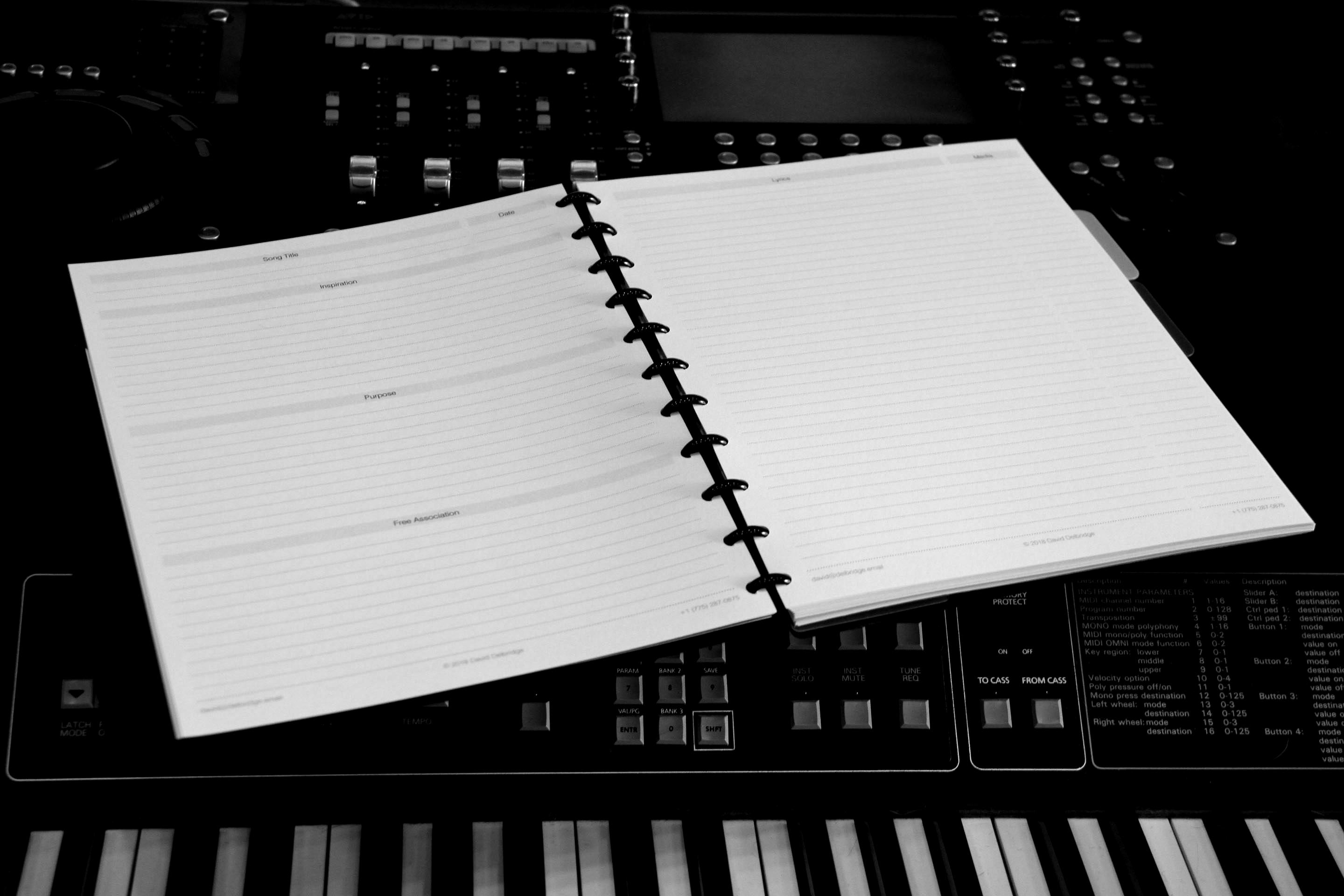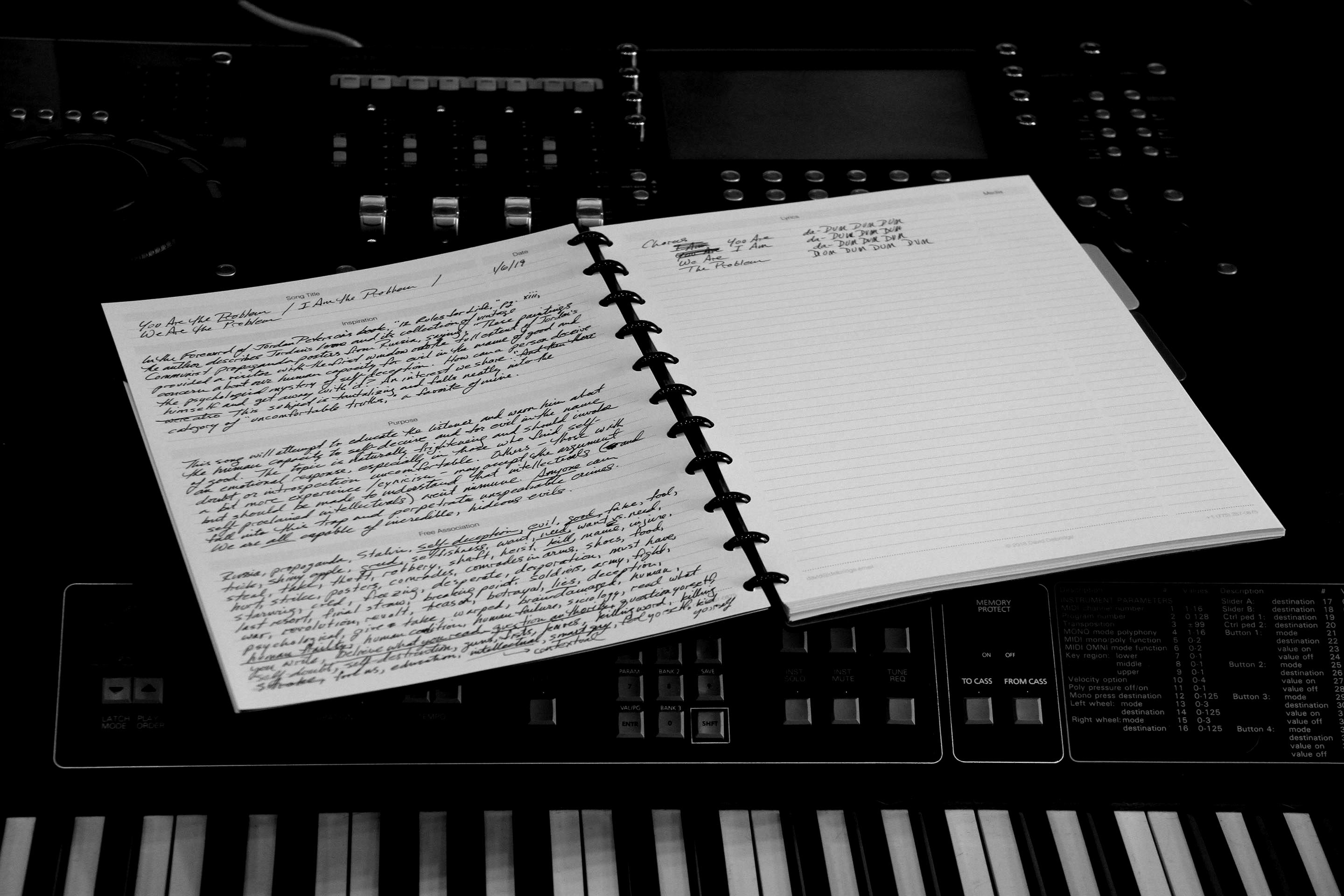Next week, I’m heading to London for seven days of songwriting tourism. Okay, that’s not a real thing, but it should be. Any tunesmith will tell you, nothing obliterates writer’s block like travel – the more exotic, the better. I’ll start at Highgate Cemetery and finish with the National Gallery, or perhaps Tate Modern, where I hope to find more of the dark imagery that inspires my diabolical juices.
In preparation, I crafted a new songwriting notebook – one that supports my unique workflow. And matches my outfit. Because nothing screams “punk rock” like a couture songwriting notebook. And, more importantly, because nothing screams “suicide risk” like a dog-eared Trapper Keeper in the armpit of a 50-year-old “songwriter.” Pick your poison. I choose rock. “Double-goat horns, baby!”
Building the Couture Songwriting Notebook
I received at least one – okay, just one – request to procure a notebook such as mine, so I’m sharing my recipe here, along with the vector art I created for the pages – technically, “worksheets.” Feel free to download, modify, and re-share as you wish. In return, I ask that you kindly add my music to your streaming playlists and loop-play ad infinitum. Seriously, 24/7. If just 24 billion people will do this for me, I can earn $3.25 from Spotify. In seventeen years.
What constitutes a kick-ass songwriting notebook?
Construction
A proper songwriting notebook is compact and lightweight, so your hike through the Himalayas needn’t be sans toilet paper, and so it’ll fit in an accessible pocket. The notebook. Okay, and the toilet paper.

In order to populate the notebook with custom worksheets (described below), it also needs an impermanent binding. Options that don’t require investment in a pricey binding machine (e.g., Velo, Spiral, Wire-O) include traditional loose leaf ring binders, binding rings, screw posts, report covers, and disk binding systems. I chose one of the newer Discbound™ notebook systems, because it’s compact and lightweight. The notebooks are available in a variety of hard, leather covers and lightweight, flexible plastic covers, and in two sizes – standard (8 1/2″ x 11″) and half-page (5 1/2″ x 8 1/2″). If you wish to knock off my bad-ass couture, you’ll need one such notebook and the proprietary hole puncher ($37.00).
And paper. I grabbed some “resume” paper from the office supply store. It’s heavy and regal – adds a touch of elegance to this craft of songwriting, if that’s possible. Yeats, Rumi, Longfellow – they didn’t use “copy” paper either. No way.
The Worksheets
My songwriting worksheets follow prevailing standards in software UI design, affording the writer lots of working space with few distractions. Two pages are afforded to each song – the left page for preliminary work and the facing page for actual lyrics.
In my not-at-all-humble opinion, this beats the crap out of prefab diaries/journals for songwriting, unless, of course, there’s unicorns on them and they’re super-duper adorable. Or disfigured. Or, maybe zombie unicorns. “Braaaaains!” Yeah, I’d buy that journal. But know this: Those sweet-ass unicorns are gonna get in your head every time you open that book. Not bad, if you’re Led Zeppelin and digging on Tolkein, but it’s been done. Free your mind. White space is your friend.

Now, here’s where the personalization, or “couture,” comes in. I designed these worksheets to support my particular songwriting workflow while also encouraging good habits and efficiency, as suggested by some experts in the field. Consequently, you won’t find these sections in off-the-rack songwriting notebooks:
Inspiration
This section of the worksheet captures the moment of inspiration – the environment, the mood, the physical sensations – or perhaps something more literal – a conversation, novel, artwork, lasagna, etc. Or both.
A thorough response serves two purposes: First, when it comes to revisiting and rewriting the song, a quick review transports this writer back, instantly restoring my muse and enthusiasm. Second, a deep dive often produces useful keywords and phrases for the Free Association phase, described below.
Purpose
Writing without purpose is bad. Very bad. “Good God, man!” One ends up with too many words pointing in too many directions (or no particular direction at all). Commence tail-chasing, writer’s block, and self-loathing. “Cripes, I suck! Mom was right!”
But when we take a moment to determine the purpose of the song, a chorus and title can jump off the page and punch us in our collective mouths, while the progression of verses also becomes obvious. Well, sometimes anyways.
I often think of this as the song’s “call to action,” to borrow from marketing parlance. In other words, what exactly, do we want the listener to do? Laugh? Cry? Dance? Learn? And no, “entertain the listener” is a bullshit answer. We must explain how and why the song will accomplish this, or the exercise is pointless. As with the Inspiration exercise, describing the song’s purpose can also pull useful words and phrases from our subconscious, for the Free Association phase, coming up in 3, 2, 1….
Free Association
This section is for stream-of-consciousness wordplay. Anything and everything that pops into my brain (minus all the boobs) goes here. No filters. No rules. Two men go in – one man comes out.
Some words and phrases will stand out as particularly powerful and engaging. [Many will be crap.] I like to go back and circle those. The powerful ones. Not the crap. With enough circled words and phrases, a song can virtually write itself.
Of course, putting your deepest, weirdest thoughts on paper can be dangerous – to your family, your relationships, your political career. But self-censorship undermines the exercise. Instead, I recommend an unfiltered deep dive, with a promise to yourself to redact the embarrassing bits after-the-fact. Hopefully, that’ll take the edge off. Now, go crazy, you sick bastard.
Other Features
The worksheets are otherwise self-explanatory, with a few exceptions: For starters, if you’re wondering why three lines are afforded to the song’s title, understand that a first-draft title rarely goes unchanged. Nor does a third-draft title. A date field allows the writer to timestamp the inception of the project, which can be helpful for recalling events and locating related media files (discussed in a moment). Each page contains a copyright notice and contact info, in case it is lost or shared with a spontaneous collaborator. The Lyrics section offers a place to list relevant media. This is where I denote images, voice memos, and other digital files that relate to the song – a hummed melody, a lyric, a picture of the statue that inspired it, etc. It’s not always necessary (or convenient) to record the file’s name. However, when I see “voice memo,” it is enough to prevent me from forgetting that a sung melody exists. Somewhere. I’ll have plenty of time to track it down when I’m home.
Do Your Worst
Go ahead. Hack my worksheets. You know you want to. Beat them to submission. Bend them to your will. [My safe word is “harder.”] Mangle them to suit your songwriting workflow. And your hideous, albeit genius, fashion sense. [Or, leave the contact and copyright info unchanged, so that I may forever enjoy your residuals.] Here’s a few things my songwriting notebook doesn’t include, but might be valuable to you:
Rhymes
Berklee College of Music professor, Pat Pattison, suggests a thorough investigation of rhymes in the early stages of writing – perhaps before a verse or chorus are even considered. For this, the songwriting worksheet needs a 10 x 10 or greater grid, whereby the most relevant and useful words (the ones you circled in the Free Association section, perhaps) can be written on the top row, with their best rhymes, culled from a rhyming dictionary, listed beneath.
Musical Staves
Many of the prefab songwriting notebooks you’ll find in retail shops offer musical staves for recording a melody. Personally, I prefer to record musical ideas with a portable audio recorder, whether a dedicated device or an app on my smart phone. It’s fast and promotes stream-of-consciousness discovery. Then again, there’s something to be said for keeping things in one place and for committing an idea to the page. And if musical notation is your jam, then by all means, run with it.
Song Structure
Some songwriting notebooks dedicate space for three verses and a chorus, for example. That’s a bit too cookie-cutter for my taste. I don’t want to be subconsciously dissuaded from writing an extra verse, a bridge, break, or instrument solo, for example.
Guitar Chord Diagrams
I should probably write with the guitar more than I do. I like that it forces me to think in terms of chords, rather than mere notes. However, my songwriting notebook is designed for travel and I rarely travel with a guitar, so….
Guitar Tablature
Same thing.
What’s left? Get yourself a hot glue gun, some faux leather, and rhinestones.
Downloads
Here’s the original vector art document in its native CorelDRAW X6 file format. Unfortunately, the software couldn’t produce reliable versions in other application file formats (e.g., Adobe Illustrator), so I opted to produce a fillable PDF form instead. Unless you want to make sweeping changes to the worksheet layout, this is probably the better way to go anyways. Feel free to edit and re-share the form, following a Creative Commons Attribution-NonCommercial 4.0 International license. For commercial use, please contact me. I’m all ears. And mouth. That is, I’m hungry. Anything helps.
UPDATE: A new version (v3.0) of the Songwriting Notebook is available here. It includes the aforementioned Rhymes worksheet and three types of optional Music Notation worksheets, a songwriting Reference section, and several other productivity improvements.
| Document | File Format | Download |
|---|---|---|
| Songwriting Notebook v2.2 |
CorelDRAW X6 (.CDR) | download |
| Songwriting Notebook v2.2 (fillable form) |
Adobe Acrobat (.PDF) | download |
Enjoy! And please feel free to share your songwriting methods and notebook suggestions below.
Beautifully conceived and written! Of coursE, I’m your biggest fan!
I have a “fan?” Sweet.